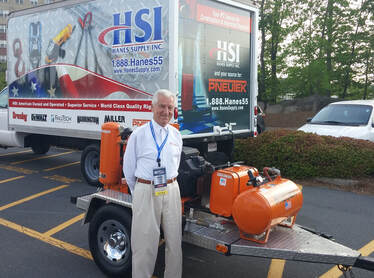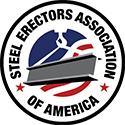The Career Accelerator Program with Steel (CAPS) is a four-year project management development initiative that takes place at NASCC: The Steel Conference. Participants, known as CAPS Fellows, attend specialized project management sessions with the rest of their cohort and receive additional training focused on their areas of project management, including fabrication, erection, and engineering.
CHICAGO - In less than two months, more than 5,000 construction and design professionals will gather in Charlotte, N.C., to learn the latest techniques and innovations and see the newest products at NASCC: The Steel Conference.
This year’s Steel Conference incorporates QualityCon, with more than 20 sessions about quality and AISC Certification, as well as SafetyCon, which features a dozen sessions about the most important part of any jobsite. (Visit aisc.org/nascc to search the schedule by track.) One registration includes the specialty conferences and the main conference, with technical sessions packed full of actionable information you can put into practice as soon as you get home--more than 200, in all! AISC has invited experts and industry leaders to share the latest on crucial topics like:
The Steel Conference will also feature the biggest exhibit hall in the show’s history, with more than 280 innovators showcasing the products and services you need to know about right now. AISC offers special rates for multiple registrants from the same firm, recent graduates, and public agency employees. Visit aisc.org/nascc to learn more and register, and contact [email protected] with any questions. To combat the dangers of heat exposure, OSHA reminds employers and workers not to ignore the dangers of working in hot weather – indoors and out. Incorporating water, rest and shade can be the difference between ending the workday safely or suffering serious injuries or worse.
OSHA and NIOSH have released a free app, OSHA-NIOSH Heat Safety Tool, that calculates a worksite's heat index and shows the associated risk levels. Users will see precautionary recommendations specific to heat index risk levels to help protect employees from heat-related illness. OSHA's Occupational Heat Exposure page explains the symptoms of heat illness, first aid measures to provide while waiting for help, engineering controls and work practices to reduce workers' exposure to heat, and training. Read More.  Every industry is influenced in immeasurable ways by the creative thinkers and inventors who change the way work gets done. For contractors involved in steel decking, that person was Harry Haytayan, Sr. (July 19, 1929—May 13, 2021), a Professional Engineer and founder of Pneutek, Inc. The pneumatic fastening tools and methods Haytayan invented have helped make mechanical fastenings for attaching steel deck the leading process in the industry. By Bryan McClure We currently live in a world with ever-changing challenges as it relates to fall protection. It used to be as simple as telling workers to “stay tied off 100% of the time.” Or “make sure your anchor point can support your pickup truck (5000 lbs.)!” At the time, it was a victory just to get workers to tie off. But since the early 1990s, there have been great strides in fall protection planning, training and
development. Product innovation has also helped to protect ironworkers from falls in ways we never expected 25 years ago. These innovations have led to a multitude of different products and manufacturers, all with different acceptable uses and component compatibilities. As a result, equipment is often used incorrectly or in the wrong situations. These are three of the most common mistakes I frequently see on steel erection sites. SEAA supports the National Safety Stand-Down to Prevent Falls in Construction. The week-long focus on fall prevention will be held May 3-7, 2021.
Erectors are encouraged to plan events at their job sites. In April, SEAA will distribute to members tips for holding an effective safety stand down and recommendations on topics relevant to fall prevention in steel erection. Members will have the option to order banners and hard stickers to utilize during their events. In addition, SEAA member Trivent Safety Consulting will offer members a free virtual Ironworkers Fall Protection Awareness class on May 5, 2021 at 11 AM MST taught by Scott Seppers. The one hour class will focus on Overview of OSHA’s Fall Protection Standards for Ironworkers- Subpart R & Subpart M; SRl’s- Overhead vs. Leading/Sharp Edge; and Fall Arrest Component Compatibility. “We suggest choosing a topic that employees will relate to, either something that is specific to your job site or workforce or that comes from past incidents or near misses,” suggests Glen Pisani of MAS Building & Bridge in Massachusetts and a SEAA board member. “The tips and banner packages are designed to make this easy for erectors of all sizes,” said Pisani. SEAA members can post their event photos on social media using hashtags #standdown4safety and #seaa. Members can order their SEAA Stands with Ironworkers banner and hard hat stickers at www.seaa.net/standdown.html. “The materials aren’t dated, so they can be used again and again for future Fall Prevention Stand Down meetings,” said Pisani. Deadline to place an order is April 19.  The second round of the Payroll Protection Plan (PPP) loans opened on January 11, 2021. The U.S. Small Business Administrations (SBA) and the U.S. Department of Treasury released the final guidance for first time applications, and stronger stipulations for second time borrowers. Forgivable PPP loans require that 60 percent of the loan pay employees & wages and 40 percent is used for rent, utilities, mortgage interest payments and other expenses. First time applicants can apply for loan coverage for any length between 8 and 24 weeks. Among the other business-related expenses that can be covered by the loan are supplier costs and property damage. Second time borrowers must have fewer than 300 employers, and must prove that they suffered at least a 25 percent drop in gross receipts between comparable quarters in 2019 and 2020. Reduce Spread of Coronavirus in Construction with While the world continues to wait for a vaccine for COVID-19, employers will need to remain up to date and vigilant on safety protocols on the jobsite, especially as we head into the winter months.
A study, published on October 29, 2020, by the University of Texas at Austin, found a connection between construction sites that did not have COVID-19 restrictions in place, and higher hospitalization rates in surrounding areas. The study, based on residents in the Austin-Round Rock metro area, discovered that the risk of coronavirus hospitalization in the construction industry is five times more than other occupations. However, on construction sites where safety measures were in place, including equipment cleaning, protective equipment and limits on worker capacity, transmission risk was decreased by 50%. As of October 30, 2020, OSHA has cited 144 establishments, with penalties totaling over $2 million dollars. While the majority of violations are in healthcare and food processing, the construction industry can use this information to better understand what the most frequent citations are. It is recommended by the CDC and OSHA that employers create a plan to protect employees to prevent the spread of COVID-19 on construction job sites. CPWR has created an Exposure Control Planning Tool that can help employers develop a written plan to help protect employees, keep job sites open, and help prevent delays. |



 RSS Feed
RSS Feed
